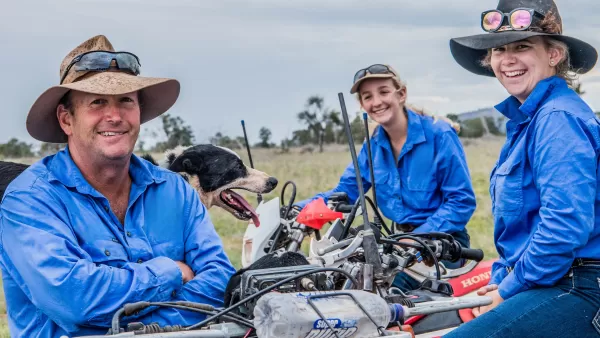Malanda Dairy Farm
Energy Savings: 2% | Cost Savings: $7,939 | Capital Cost: $93,976 | CO2 Savings: 1.3 | Project Status: implemented
Industry:
Dairy
Location:
Atherton Tablelands
Pump Type:
Centrifugal
Irrigation Type:
Centre Pivot
Technology:
Irrigation and Pumps
The site utilises 28ha of solid set irrigation fed by an underground bore pump to improve feed for the 140 head of milking cows.
The annual energy consumption for the site during the 2018-2019 period was 118,323 kWh at a cost of $23,356, split between pumping for irrigation (64%) and milking operations (36%). The energy consumption on the farm consists mainly of:
- Pumping for irrigation
- Milk cooling
- Stock and dairy water
- Water heating
- Milk harvesting and stalling
A recent energy audit showed how improving the current systems across the farm can lead to energy and cost savings. The audit recommendations can be seen in Table 1.
Table 1. Costs and savings from audit recommendations.
| Recommendation | Annual Energy Savings (kWh) | Annual Costs Savings ($) | Emission Savings
(tCO2-e) |
Capital Cost ($) | Payback Period (Years) |
| Reduce cooling costs by improving milk cooling efficiency | 1,087 | 287 | 0.8 | 0 | Immediate |
| Installation of a VSD on bore pump | 2,190 | 577 | 1.7 | 2,300 | 4 |
| Install 20kW Solar PV | N/A | 3,857 | N/A | 30,000 | 7.8 |
| Remove Existing Pump Repair Bore Screen and Casing and Reinstate | 24,030 | 8.,969 | 19.4 | 18,000 | 2 |
| Replace Existing Pump Repair Bore Screen and Casing and | 37,000 | 4.1 | |||
| Install Solid Set with CU of 85% | 11,800 | 6,950 | 9.5 | 30,000 | 4.3 |
| Total | 39,107 | 20,640 | 31.4 | 80,300-99,300 | 3.6-4.0 |
N.B. Replace existing pump includes production benefit energy savings which equate to $3,969. Install solid set has production benefit, energy savings which equate to $1,950
At the time of the audit, the farm was on an obsolete tariff and a review of the pumping system showed that costs would be increased by $4,977 by switching to Tarif 22A.
Given the audit information and after talks with a local irrigation business, the farmer decided to improve the irrigation system. Instead of the solid set recommended, the farmer implemented a new centre pivot irrigator with a 150mm PVC mainline. On closer inspection, the proposed solid set irrigation was estimated to have a duty point for the bore pump of 27LPS at 117m total head, whereas the centre pivot will be performing at 29LPS at 107 total head showing a reduction in pressure and an improvement in flow.
The savings made have been measured in a Measurement and Verification (M&V) process, as outlined in Table 2.
Table 2. Estimated and Actual energy and cost savings.
| Metric | Audit Estimation Centre Pivot | M&V Calculation Centre Pivot | Variation (%) |
| Energy Savings (kWh) | 3,086 | 1,647 | -47 |
| Cost Savings ($) | 8,270 | 7,939 | -4 |
The lower energy savings obtained from the M&V calculations compared to those estimated in the audit have been influenced by different assumptions on the use of water by the irrigation system. The cost savings have been maintained due to the increase in dry matter production.
The main savings from implementation have been achieved from an increase in production of 2t D.M./ha/year, due to improvements in the area irrigated and irrigation efficiency, adding $5000 per annum as reported in the energy audit. Labour efficiency has also improved saving roughly $2,560 per year, this is achieved by remotely controlling the pivot and minimal time required to set up, turn on or off.
From the implementation of recommendations in the audit, the farm has reduced total energy consumption by 2% and total costs by 34%, with Carbon emission savings of 1.3 t/CO2-e per year.
Table 3. Pre and Post Implementation energy consumption, costs and productivity improvements.
| Metric | Pre-implementation | Post-implementation | Reduction (%) |
| Energy Consumption (kWh) | 118,323 | 116,676 | 2 |
| Cost ($) | 23,356 | 4,317 | 34 |
| Energy Productivity (kWh/cow) | 845.2 | 833.4 | 2 |
The site could see further production benefits by increasing the carrying capacity due to the increase in dry matter or maximising pasture utilisation, increasing milk production and reducing the kWh/L of milk and milk solids produced.
This case study was developed as part of the Energy Savers Plus Extension Program, delivered by the Queensland Farmers Federation with support and funding from the Queensland Department of Energy and Public Works.

